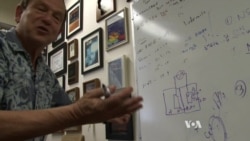Kenneth Nealson can be described in many ways, including "expert in microbiology and biochemistry." But that's not the one he is most proud of.
"People call me the 'father of Shewanella,' " said Nealson, a professor of Earth sciences and biological sciences at the University of Southern California in Los Angeles.
Shewanella is an unusual bacterium that shocked the scientific community. Nealson discovered it 25 years ago in a lake. Like other organisms, it breathes oxygen, but it also breathes rock.
Nealson displayed the phenomenon in a time-lapse video that shows Shewanella making a piece of manganese oxide slowly disappear.
"That particle that you saw disappear before your eyes in 18 hours, under those conditions, should have been stable for thousands of years," he said.
All living things, including people, make energy through what’s called electron transfer. It involves taking electrons from the food we eat.
"When we breathe in oxygen, we give electrons to it, and it’s that voltage that allows us to make energy," Nealson said.
This process usually happens internally. But for the Shewanella and other mineral-breathing organisms, the electron transfer happens outside the cell.
When the process was discovered, it seemed impossible to the scientific community.
"This was one of the most exciting times in my career — when you realize you have something that probably no one else has and that almost no one is going to believe," Nealson said.
Since then, microbiologists have found other organisms that breathe metal, and Nealson said they are finally making it into science textbooks.
Building on Nealson’s work, one researcher in his lab, Annette Rowe, just made another discovery: bacteria that eat rock in ocean sediments as an energy source and transfer electrons from outside the cell membrane into the cell.
"So you actually don’t have to internalize it to get energy from it," Rowe said.
Nealson said the discovery is "going to be as wacky" as the Shewanella finding, "because you could see from the reviews of this that some people just didn’t believe it."
These findings have implications that extend to outer space and how life might exist on a planet like Mars. Nealson said one of his former students is now building an instrument that will attach to the arm of a planetary rover and give scientists a special set of eyes on the 2020 Mars mission.
"If you picked up a nice fluorescent signal from a Mars rock or sediment or core if we drilled into it, and all of a sudden you saw a certain colors of fluorescence, you would say, 'Whoop, stop the train, let’s get a sample of this,' and look at it in more detail."
Meanwhile, scientists are drilling into the lower parts of the Earth’s crust, several kilometers down, to see whether there are forms of life there, living in ways much different than what we know as life on the surface.









